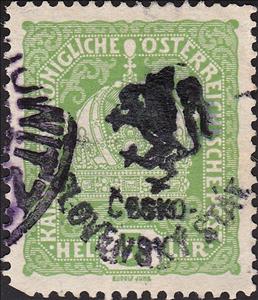Stamp: Austria Stamps Overprinted "ČESKO-SLOVENSKÝ STÁT" and Lion (Czechoslovakia 1918)
Austria Stamps Overprinted "ČESKO-SLOVENSKÝ STÁT" and Lion (Czechoslovakia 1918)
08 November (Czechoslovakia ) within release Revolutionary Issues 1918 : Budejovicke Series goes into circulation Stamp Austria Stamps Overprinted "ČESKO-SLOVENSKÝ STÁT" and Lion face value 5 Austro-Hungarian heller
| Stamp Austria Stamps Overprinted "ČESKO-SLOVENSKÝ STÁT" and Lion in catalogues | |
|---|---|
| Michel: | Mi: CS LR86 |
| POFIS: | POF: CS RV86 |
Stamp is vertical format.
Black overprint with lion image and inscription "ČESKO-SLOVENSKÝ STÁT" on Mi:AT 186Also in the issue Revolutionary Issues 1918 : Budejovicke Series:
- Stamp - Austria Stamps Overprinted "ČESKO-SLOVENSKÝ STÁT" and Lion face value 6;
- Stamp - Austria Stamps Overprinted "ČESKO-SLOVENSKÝ STÁT" and Lion face value 10;
- Stamp - Austria Stamps Overprinted "ČESKO-SLOVENSKÝ STÁT" and Lion face value 15;
- Stamp - Austria Stamps Overprinted "ČESKO-SLOVENSKÝ STÁT" and Lion face value 80;
- Stamp - Austria Stamps Overprinted "ČESKO-SLOVENSKÝ STÁT" and Lion face value 3;
- Stamp - Austria Stamps Overprinted "ČESKO-SLOVENSKÝ STÁT" and Lion face value 30;
- Stamp - Austria Stamps Overprinted "ČESKO-SLOVENSKÝ STÁT" and Lion face value 5;
- Stamp - Austria Stamps Overprinted "ČESKO-SLOVENSKÝ STÁT" and Lion face value 50;
- Stamp - Austria Stamps Overprinted "ČESKO-SLOVENSKÝ STÁT" and Lion face value 25;
- Stamp - Austria Stamps Overprinted "ČESKO-SLOVENSKÝ STÁT" and Lion face value 12;
- Stamp - Austria Stamps Overprinted "ČESKO-SLOVENSKÝ STÁT" and Lion face value 90;
- Stamp - Austria Stamps Overprinted "ČESKO-SLOVENSKÝ STÁT" and Lion face value 60;
- Stamp - Austria Stamps Overprinted "ČESKO-SLOVENSKÝ STÁT" and Lion face value 20;
- Stamp - Austria Stamps Overprinted "ČESKO-SLOVENSKÝ STÁT" and Lion face value 40;
- Stamp - Austria Stamps Overprinted "ČESKO-SLOVENSKÝ STÁT" and Lion face value 2;
- Stamp - Austria Stamps Overprinted "ČESKO-SLOVENSKÝ STÁT" and Lion face value 5;
- Stamp - Austria Stamps Overprinted "ČESKO-SLOVENSKÝ STÁT" and Lion face value 10;
- Stamp - Austria Stamps Overprinted "ČESKO-SLOVENSKÝ STÁT" and Lion face value 4;
- Stamp - Austria Stamps Overprinted "ČESKO-SLOVENSKÝ STÁT" and Lion face value 20;
- Stamp - Austria Stamps Overprinted "ČESKO-SLOVENSKÝ STÁT" and Lion face value 10;
- Stamp - Austria Stamps Overprinted "ČESKO-SLOVENSKÝ STÁT" and Lion face value 1;
- Stamp - Austria Stamps Overprinted "ČESKO-SLOVENSKÝ STÁT" and Lion face value 2;
- Stamp - Austria Stamps Overprinted "ČESKO-SLOVENSKÝ STÁT" and Lion face value 3;
- Stamp - Austria Stamps Overprinted "ČESKO-SLOVENSKÝ STÁT" and Lion face value 15;
- Stamp - Austria Stamps Overprinted "ČESKO-SLOVENSKÝ STÁT" and Lion face value 10;
- Stamp - Austria Stamps Overprinted "ČESKO-SLOVENSKÝ STÁT" and Lion face value 4;
- Stamp - Austria Stamps Overprinted "ČESKO-SLOVENSKÝ STÁT" and Lion face value 5;
- Stamp - Austria Stamps Overprinted "ČESKO-SLOVENSKÝ STÁT" and Lion face value 5;
- Stamp - Austria Stamps Overprinted "ČESKO-SLOVENSKÝ STÁT" and Lion face value 5;
- Stamp - Austria Stamps Overprinted "ČESKO-SLOVENSKÝ STÁT" and Lion face value 1;
- Stamp - Austria Stamps Overprinted "ČESKO-SLOVENSKÝ STÁT" and Lion face value 2;
- Stamp - Austria Stamps Overprinted "ČESKO-SLOVENSKÝ STÁT" and Lion face value 50;
- Stamp - Austria Stamps Overprinted "ČESKO-SLOVENSKÝ STÁT" and Lion face value 2;
- Stamp - Austria Stamps Overprinted "ČESKO-SLOVENSKÝ STÁT" and Lion face value 30;
- Stamp - Austria Stamps Overprinted "ČESKO-SLOVENSKÝ STÁT" and Lion face value 10;
- Stamp - Austria Stamps Overprinted "ČESKO-SLOVENSKÝ STÁT" and Lion face value 25;
- Stamp - Austria Stamps Overprinted "ČESKO-SLOVENSKÝ STÁT" and Lion face value 40;
- Stamp - Austria Stamps Overprinted "ČESKO-SLOVENSKÝ STÁT" and Lion face value 3;
Stamp Austria Stamps Overprinted "ČESKO-SLOVENSKÝ STÁT" and Lion it reflects the thematic directions:
A coat of arms is an heraldic visual design on an escutcheon (i.e. shield), surcoat, or tabard. The coat of arms on an escutcheon forms the central element of the full heraldic achievement which in its whole consists of shield, supporters, crest, and motto. A coat of arms is traditionally unique to an individual person, family (except in the United Kingdom), state, organisation or corporation.
In British heraldry, a coronet is any crown whose bearer is less than sovereign or royal in rank, irrespective of the crown's appearance. In other languages, this distinction is not made, and usually the same word for crown is used irrespective of rank (German: Krone, Dutch: Kroon, Swedish: Krona, French: Couronne, etc.) In this use, the English coronet is a purely technical term for all heraldic images of crowns not used by a sovereign, and implies nothing about the actual shape of the crown depicted. A Coronet is another type of crown, but is reserved for the lower ranks of nobility like Marquesses and Marchionesses, Earls and Countesses, Barons and Baronesses, and some Lords and Ladies. The specific design and attributes of the crown or coronet signifies the hierarchy and ranking of its owner.
personal ornaments, such as necklaces, rings, or bracelets, that are typically made from or contain jewels and precious metal.


